Jinhyeok Choi
Unveiling the Threat of Fraud Gangs to Graph Neural Networks: Multi-Target Graph Injection Attacks against GNN-Based Fraud Detectors
Dec 24, 2024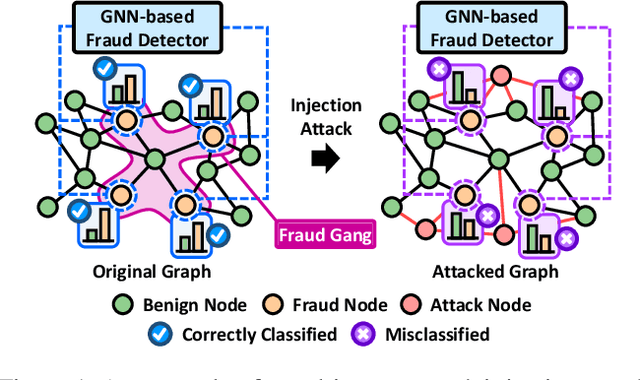
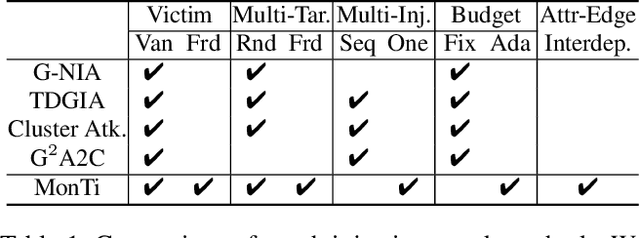
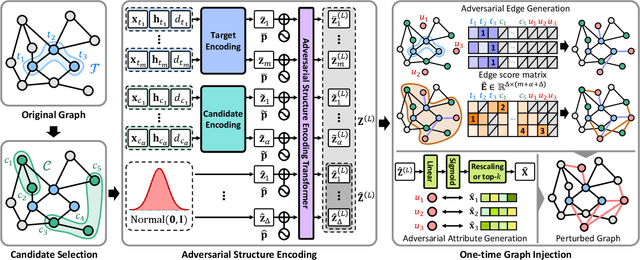

Abstract:Graph neural networks (GNNs) have emerged as an effective tool for fraud detection, identifying fraudulent users, and uncovering malicious behaviors. However, attacks against GNN-based fraud detectors and their risks have rarely been studied, thereby leaving potential threats unaddressed. Recent findings suggest that frauds are increasingly organized as gangs or groups. In this work, we design attack scenarios where fraud gangs aim to make their fraud nodes misclassified as benign by camouflaging their illicit activities in collusion. Based on these scenarios, we study adversarial attacks against GNN-based fraud detectors by simulating attacks of fraud gangs in three real-world fraud cases: spam reviews, fake news, and medical insurance frauds. We define these attacks as multi-target graph injection attacks and propose MonTi, a transformer-based Multi-target one-Time graph injection attack model. MonTi simultaneously generates attributes and edges of all attack nodes with a transformer encoder, capturing interdependencies between attributes and edges more effectively than most existing graph injection attack methods that generate these elements sequentially. Additionally, MonTi adaptively allocates the degree budget for each attack node to explore diverse injection structures involving target, candidate, and attack nodes, unlike existing methods that fix the degree budget across all attack nodes. Experiments show that MonTi outperforms the state-of-the-art graph injection attack methods on five real-world graphs.
SpoT-Mamba: Learning Long-Range Dependency on Spatio-Temporal Graphs with Selective State Spaces
Jun 17, 2024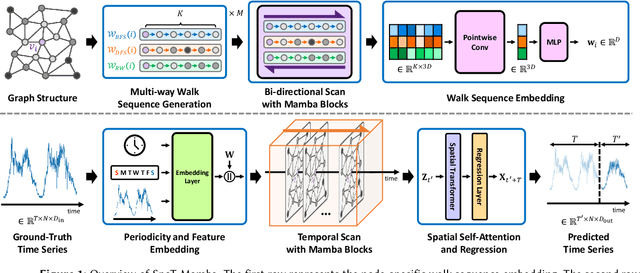


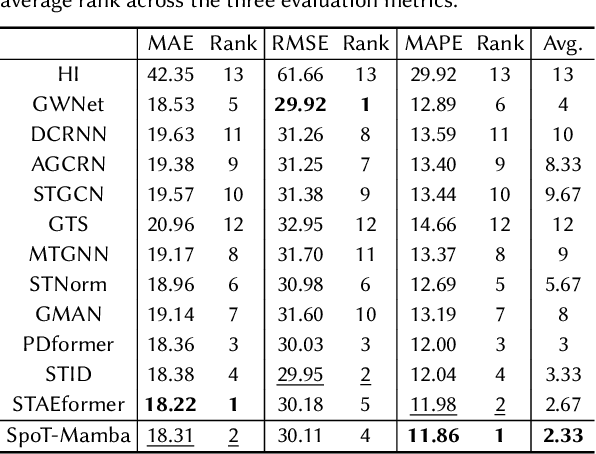
Abstract:Spatio-temporal graph (STG) forecasting is a critical task with extensive applications in the real world, including traffic and weather forecasting. Although several recent methods have been proposed to model complex dynamics in STGs, addressing long-range spatio-temporal dependencies remains a significant challenge, leading to limited performance gains. Inspired by a recently proposed state space model named Mamba, which has shown remarkable capability of capturing long-range dependency, we propose a new STG forecasting framework named SpoT-Mamba. SpoT-Mamba generates node embeddings by scanning various node-specific walk sequences. Based on the node embeddings, it conducts temporal scans to capture long-range spatio-temporal dependencies. Experimental results on the real-world traffic forecasting dataset demonstrate the effectiveness of SpoT-Mamba.
Dynamic Relation-Attentive Graph Neural Networks for Fraud Detection
Oct 09, 2023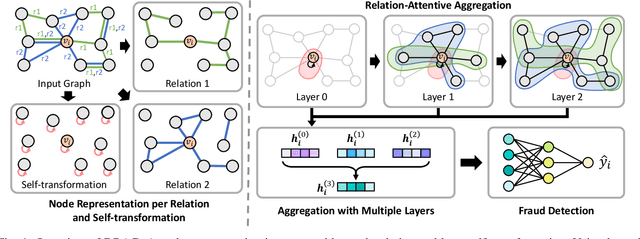

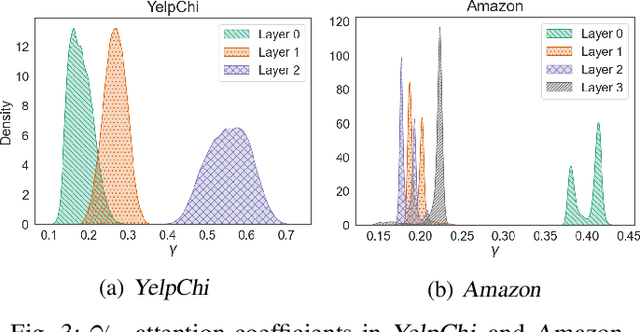
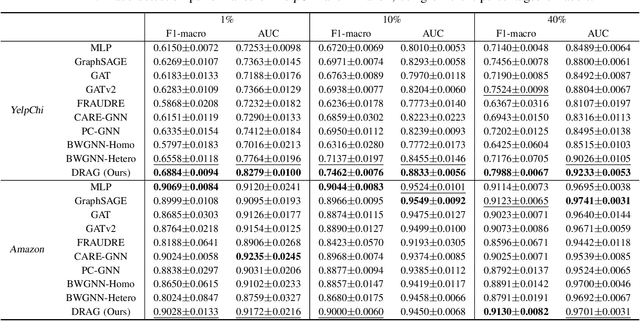
Abstract:Fraud detection aims to discover fraudsters deceiving other users by, for example, leaving fake reviews or making abnormal transactions. Graph-based fraud detection methods consider this task as a classification problem with two classes: frauds or normal. We address this problem using Graph Neural Networks (GNNs) by proposing a dynamic relation-attentive aggregation mechanism. Based on the observation that many real-world graphs include different types of relations, we propose to learn a node representation per relation and aggregate the node representations using a learnable attention function that assigns a different attention coefficient to each relation. Furthermore, we combine the node representations from different layers to consider both the local and global structures of a target node, which is beneficial to improving the performance of fraud detection on graphs with heterophily. By employing dynamic graph attention in all the aggregation processes, our method adaptively computes the attention coefficients for each node. Experimental results show that our method, DRAG, outperforms state-of-the-art fraud detection methods on real-world benchmark datasets.
Learning Vehicle Dynamics from Cropped Image Patches for Robot Navigation in Unpaved Outdoor Terrains
Sep 06, 2023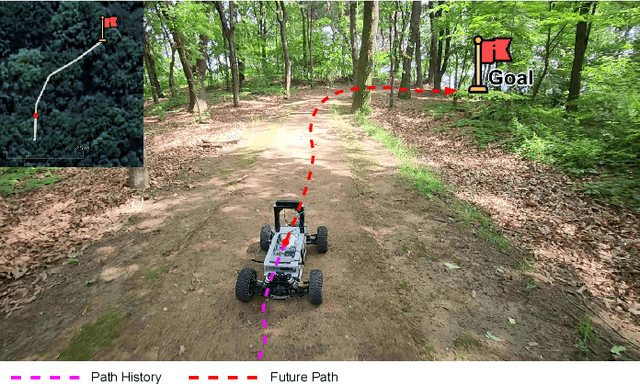
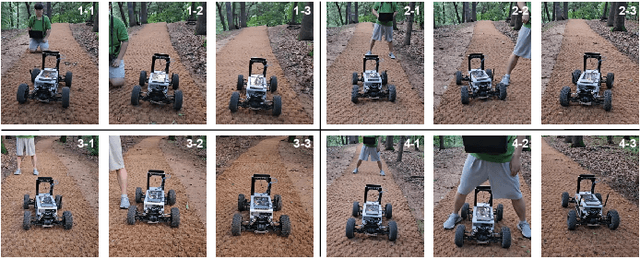

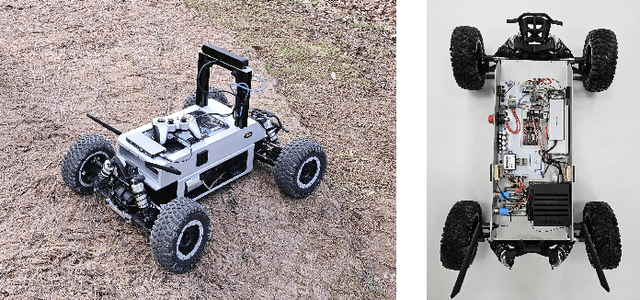
Abstract:In the realm of autonomous mobile robots, safe navigation through unpaved outdoor environments remains a challenging task. Due to the high-dimensional nature of sensor data, extracting relevant information becomes a complex problem, which hinders adequate perception and path planning. Previous works have shown promising performances in extracting global features from full-sized images. However, they often face challenges in capturing essential local information. In this paper, we propose Crop-LSTM, which iteratively takes cropped image patches around the current robot's position and predicts the future position, orientation, and bumpiness. Our method performs local feature extraction by paying attention to corresponding image patches along the predicted robot trajectory in the 2D image plane. This enables more accurate predictions of the robot's future trajectory. With our wheeled mobile robot platform Raicart, we demonstrated the effectiveness of Crop-LSTM for point-goal navigation in an unpaved outdoor environment. Our method enabled safe and robust navigation using RGBD images in challenging unpaved outdoor terrains. The summary video is available at https://youtu.be/iIGNZ8ignk0.
Not Only Rewards But Also Constraints: Applications on Legged Robot Locomotion
Aug 24, 2023



Abstract:Several earlier studies have shown impressive control performance in complex robotic systems by designing the controller using a neural network and training it with model-free reinforcement learning. However, these outstanding controllers with natural motion style and high task performance are developed through extensive reward engineering, which is a highly laborious and time-consuming process of designing numerous reward terms and determining suitable reward coefficients. In this work, we propose a novel reinforcement learning framework for training neural network controllers for complex robotic systems consisting of both rewards and constraints. To let the engineers appropriately reflect their intent to constraints and handle them with minimal computation overhead, two constraint types and an efficient policy optimization algorithm are suggested. The learning framework is applied to train locomotion controllers for several legged robots with different morphology and physical attributes to traverse challenging terrains. Extensive simulation and real-world experiments demonstrate that performant controllers can be trained with significantly less reward engineering, by tuning only a single reward coefficient. Furthermore, a more straightforward and intuitive engineering process can be utilized, thanks to the interpretability and generalizability of constraints. The summary video is available at https://youtu.be/KAlm3yskhvM.
 Add to Chrome
Add to Chrome Add to Firefox
Add to Firefox Add to Edge
Add to Edge